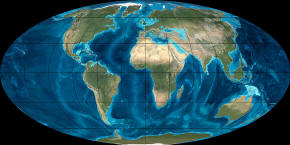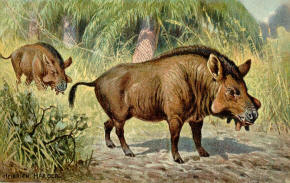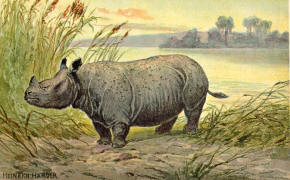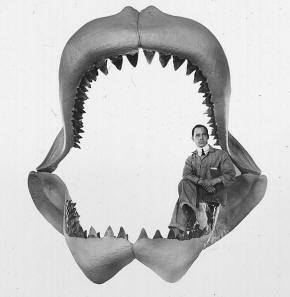The earth went from the Oligocene Epoch through the Miocene and into the Pliocene as it cooled into a series of Ice Ages. The Miocene boundaries are not marked by a single distinct global event but consist rather of regional boundaries between the warmer Oligocene and the cooler Pliocene.
The plants and animals of the Miocene were fairly modern. Mammals and birds were well-established. Whales, seals, and kelp spread.
Paleogeography
 |
| Geographic reconstruction during the Miocene, approximately 20 Ma (Picture Source) |
Continents continued to drift toward their present positions. Of the modern geologic features, only the land bridge between South America and North America was absent, although South America was approaching the western subduction zone in the Pacific Ocean, causing both the rise of the Andes and a southward extension of the Meso-American peninsula.
Mountain building took place in Western North America, Europe, and east Asia. Both continental and marine Miocene deposits are common worldwide with marine outcrops common near modern shorelines. Well studied continental exposures occur in the American Great Plains and in Argentina.
India continued to collide with Asia, creating dramatic new mountain ranges. The Tethys Seaway continued to shrink and then disappeared as Africa collided with Eurasia in the Turkish-Arabian region between 19 and 12 Ma. The subsequent uplift of mountains in the western Mediterranean region and a global fall in sea levels combined to cause a temporary drying up of the Mediterranean Sea (known as the Messinian salinity crisis) near the end of the Miocene.
The global trend was towards increasing aridity caused primarily by global cooling reducing the ability of the atmosphere to absorb moisture. Uplift of East Africa in the Late Miocene was partly responsible for the shrinking of tropical rain forests in that region, and Australia got drier as it entered a zone of low rainfall in the Late Miocene.
Flora
Grasslands underwent a major expansion; forests fell victim to a generally cooler and drier climate overall. Grasses also diversified greatly, co-evolving with large herbivores and grazers, including ruminants. Between 7 and 6 million years ago, there occurred a sudden expansion of grasses which were able to assimilate carbon dioxide more efficiently but were also richer in silica, causing a worldwide extinction of large herbivores. The expansion of grasslands and radiations among terrestrial herbivores such as horses can be linked to fluctuations in CO2.
Fauna
Both marine and continental fauna were fairly modern, although marine mammals were
 |
| Above: Illustration of Entelodon, an extinct pig-like
animal from the Miocene. Below: Illustration of Teleoceras, an extinct rhinoceras that lived in North America during the Miocene. |
 |
Unequivocally recognizable dabbling ducks, plovers, typical owls, cockatoos and crows appear during the Miocene. By the epoch's end, all or almost all modern bird families are believed to have been present; the few post-Miocene bird fossils which cannot be placed in the evolutionary tree with full confidence are simply too badly preserved instead of too equivocal in character. Marine birds reached their highest diversity ever in the course of this epoch.
Brown algae, called kelp, proliferate, supporting new species of sea life, including otters, fish and various invertebrates. The cetaceans diversified, and some modern genera appeared, such as the sperm whales. The pinnipeds, which appeared near the end of the Oligocene, became more aquatic.
Approximately 100 species of apes lived during this time. They ranged over much of the Old World and varied widely in size, diet, and anatomy.
In the oceans, modern sharks appeared at this time including the huge Megalodon.
 |
| Reconstruction of the mouth of the large shark Megalodon. |
Oceans
There is evidence from oxygen isotopes at
Deep Sea Drilling Program sites that ice began to build up in Antarctica
about 36 Ma during the
Eocene.
Further marked decreases in temperature during the
Middle Miocene at 15 Ma probably reflect increased ice growth in
Antarctica. It can therefore be assumed that East Antarctica had some
glaciers during the early to mid Miocene (23 – 15 Ma). Oceans cooled partly
due the formation of the
Antarctic Circumpolar Current, and about 15 million years ago the ice
cap in the southern hemisphere started to grow to its present form. The
Greenland ice cap developed later, in the
Middle Pliocene time, about 3 million years ago.
End of Reading
Return to the Old Earth Ministries Online Earth History Curriculum homepage.
Source: Miocene Epoch